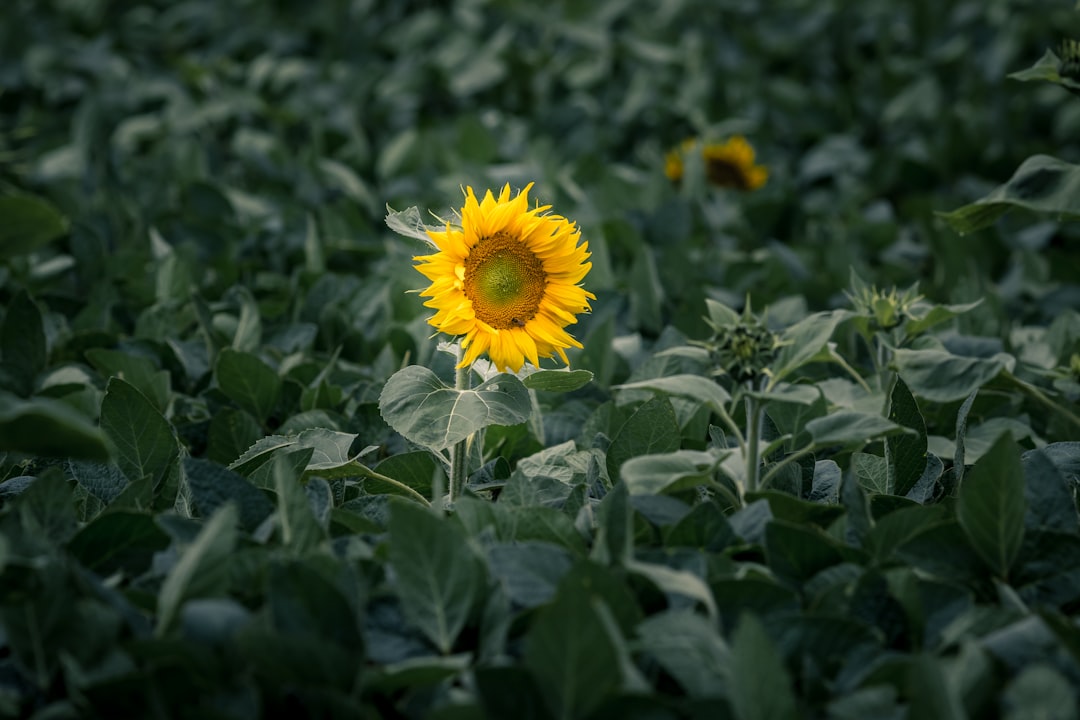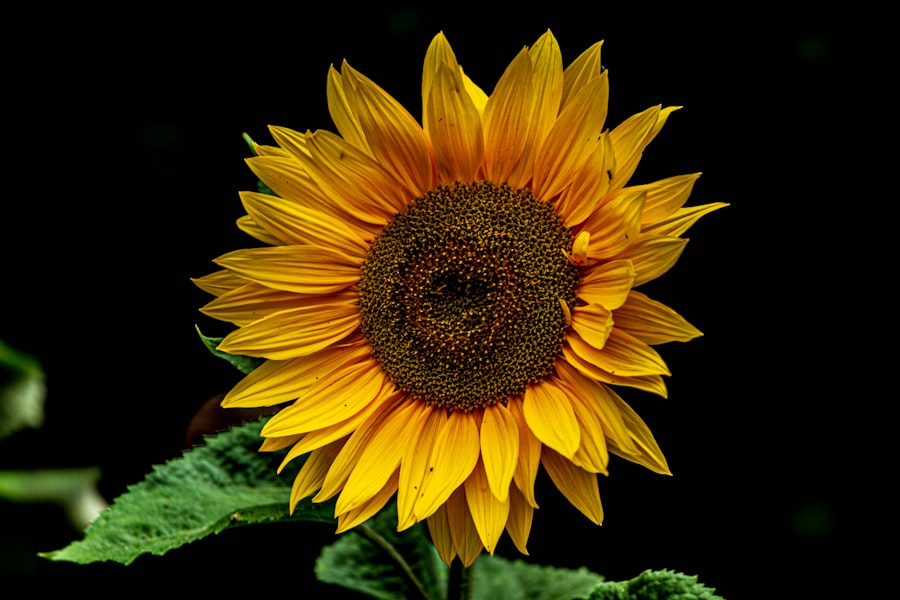Harvesting Sunflower Seeds: A Step-by-Step Guide

Sunflower seeds have a long history and have been used for various purposes throughout the years. Native to North America, sunflowers were cultivated by Native Americans for their seeds, oil, and dye. The seeds were an important food source and were also used in traditional medicine. Today, sunflower seeds are widely consumed around the world and are known for their nutritional value.
Sunflower seeds are packed with nutrients and are a great addition to a healthy diet. They are an excellent source of protein, fiber, healthy fats, vitamins, and minerals. They are also rich in antioxidants, which help protect the body against free radicals and reduce the risk of chronic diseases. Sunflower seeds are particularly high in vitamin E, which is important for skin health and immune function.
Key Takeaways
- Sunflower seeds are a nutritious and versatile food that can be used for snacking, cooking, and baking.
- Choosing the right sunflower variety is important for seed harvesting, as some varieties are better suited for this purpose than others.
- Preparing the soil for sunflower growth involves removing weeds and adding compost or fertilizer to improve soil quality.
- Planting sunflowers for seed production requires spacing the seeds properly and providing adequate water and sunlight.
- Caring for sunflowers during growth involves monitoring for pests and diseases, and providing support for tall plants.
Choosing the Right Sunflower Variety for Seed Harvesting
When it comes to seed production, not all sunflower varieties are created equal. There are different types of sunflowers that are specifically bred for seed production. These varieties have larger heads and more seeds compared to ornamental sunflowers.
When choosing a sunflower variety for seed harvesting, there are several factors to consider. First, consider the climate in your area. Some varieties are better suited for colder climates, while others thrive in warmer regions. It’s also important to consider the size of the sunflower heads and the number of seeds they produce. Look for varieties that have large heads and produce a high number of seeds per head.
Preparing the Soil for Sunflower Growth
Sunflowers require well-drained soil that is rich in organic matter. Before planting sunflowers, it’s important to prepare the soil properly to ensure optimal growth and seed production.
Start by clearing the area of any weeds or debris. Then, loosen the soil using a garden fork or tiller. This will help improve drainage and allow the roots to penetrate the soil more easily. If the soil is compacted, consider adding organic matter such as compost or well-rotted manure to improve its structure.
Next, test the soil pH. Sunflowers prefer a slightly acidic to neutral pH, around 6.0 to 7.5. If the soil is too acidic, you can add lime to raise the pH. If it’s too alkaline, you can add sulfur to lower the pH.
Planting Sunflowers for Seed Production
| Planting Sunflowers for Seed Production | Metrics |
|---|---|
| Seed Germination Rate | 85% |
| Days to Flowering | 70-90 days |
| Seed Yield per Acre | 1,000-1,500 lbs |
| Oil Content | 40-50% |
| Protein Content | 15-20% |
The best time to plant sunflowers for seed production is in late spring or early summer, when the soil has warmed up and there is no longer a risk of frost. Sunflowers require full sun to thrive, so choose a location that receives at least 6 to 8 hours of direct sunlight per day.
To plant sunflowers, start by creating rows or patches in the prepared soil. Space the rows or patches about 2 to 3 feet apart, depending on the variety. Dig holes that are about 1 to 2 inches deep and place one or two seeds in each hole. Cover the seeds with soil and water thoroughly.
Keep the soil moist but not waterlogged during germination. Once the seedlings have emerged, thin them out so that there is about 1 foot of space between each plant. This will allow the sunflowers to grow and develop properly.
Caring for Sunflowers During Growth
Watering is crucial for sunflower growth and seed production. Sunflowers have deep taproots that allow them to access water from deeper in the soil, but they still require regular watering, especially during dry periods. Water deeply once a week, providing about 1 inch of water each time.
Fertilizing sunflowers can help promote healthy growth and seed production. Before planting, incorporate a balanced fertilizer into the soil according to package instructions. Once the sunflowers have reached about 12 inches in height, side-dress them with a nitrogen-rich fertilizer to encourage strong stem and leaf growth.
Pest and disease management is also important for sunflower production. Common pests that can affect sunflowers include aphids, caterpillars, and birds. Monitor the plants regularly and take appropriate measures to control pests. Diseases such as powdery mildew and downy mildew can also affect sunflowers. To prevent these diseases, avoid overhead watering and provide good air circulation around the plants.
Identifying When Sunflowers are Ready for Harvest

Sunflowers are ready for harvest when the back of the flower head turns yellow or brown and the seeds are plump and firm. The petals will have dried up and fallen off, and the seeds will be fully developed.
Timing is crucial when it comes to sunflower seed harvest. If you wait too long, the seeds may become overripe and start to fall out of the head. On the other hand, if you harvest too early, the seeds may not be fully developed and won’t have reached their maximum size.
Harvesting Sunflower Seeds: Tools and Equipment Needed
To harvest sunflower seeds, you will need a few tools and equipment. The most important tool is a sharp knife or pair of pruning shears to cut the sunflower heads from the stalks. You will also need a bucket or container to collect the heads.
If you have a large number of sunflowers to harvest, you may also want to invest in a sunflower head stripper. This tool makes it easier to remove the seeds from the heads by rubbing them against a rough surface.
Drying and Storing Sunflower Seeds
After harvesting, it’s important to dry the sunflower seeds properly before storing them. Drying helps remove any excess moisture from the seeds, which can cause them to spoil or become moldy.
To dry sunflower seeds, spread them out in a single layer on a clean, dry surface. Make sure the seeds are not touching each other to allow for proper airflow. Place the seeds in a warm, well-ventilated area, such as a sunny windowsill or a dehydrator set to a low temperature.
Once the seeds are completely dry, store them in an airtight container in a cool, dark place. Properly stored sunflower seeds can last for several months.
Roasting Sunflower Seeds for Snacking
Roasting sunflower seeds is a popular way to enjoy them as a snack. Roasting enhances their flavor and gives them a crunchy texture.
To roast sunflower seeds, start by preheating your oven to 350°F (175°C). In a bowl, toss the sunflower seeds with a little bit of oil and your choice of seasonings, such as salt, garlic powder, or paprika. Spread the seeds out in a single layer on a baking sheet and roast them in the oven for about 10 to 15 minutes, or until they are golden brown.
Benefits of Harvesting Sunflower Seeds for Health and Nutrition
Harvesting sunflower seeds not only allows you to enjoy their delicious flavor but also provides numerous health benefits. Sunflower seeds are packed with nutrients that are essential for overall health and well-being.
Sunflower seeds are an excellent source of protein, which is important for muscle growth and repair. They also contain healthy fats, including monounsaturated and polyunsaturated fats, which help reduce inflammation and support heart health.
In addition to protein and healthy fats, sunflower seeds are rich in vitamins and minerals. They are particularly high in vitamin E, which is a powerful antioxidant that helps protect the body against free radicals and reduce the risk of chronic diseases such as heart disease and cancer.
Harvesting sunflower seeds is not only a rewarding experience but also provides numerous benefits for health and nutrition. Sunflower seeds are packed with nutrients and are a great addition to a healthy diet. They are rich in protein, healthy fats, vitamins, and minerals, and are particularly high in vitamin E.
Choosing the right sunflower variety for seed production is important to ensure optimal growth and seed yield. Preparing the soil properly and providing the necessary care during growth are also crucial for successful sunflower seed production. Harvesting, drying, and storing the seeds correctly will help preserve their quality and flavor.
Whether you enjoy sunflower seeds as a snack or use them in cooking and baking, they are a versatile and nutritious ingredient that can be enjoyed in a variety of ways. So why not try your hand at harvesting sunflower seeds and reap the benefits for your health and nutrition?
If you’re interested in learning how to get seeds from a sunflower, you might find this article from Lawn World helpful. They provide a step-by-step guide on how to harvest sunflower seeds and ensure a successful yield. Check out their article here for more information.
FAQs
What is a sunflower?
A sunflower is a tall plant with a large, yellow flower head. It is native to North America but is now grown all over the world for its seeds and oil.
Why would I want to get seeds from a sunflower?
Sunflower seeds are a nutritious snack and can also be used to grow more sunflowers. They are high in protein, healthy fats, and vitamins.
When is the best time to harvest sunflower seeds?
The best time to harvest sunflower seeds is when the flower head has turned brown and the back of the head is yellow or brown. This usually happens in late summer or early fall.
How do I harvest sunflower seeds?
To harvest sunflower seeds, cut the flower head off the plant and hang it upside down in a dry, well-ventilated area. Once the flower head is completely dry, rub the seeds off with your hands or a fork.
Can I eat sunflower seeds straight from the flower?
No, you cannot eat sunflower seeds straight from the flower. The seeds need to be dried and roasted before they are safe to eat.
How do I roast sunflower seeds?
To roast sunflower seeds, spread them out on a baking sheet and bake them in the oven at 350°F for 15-20 minutes, stirring occasionally. You can also roast them in a dry skillet on the stove over medium heat, stirring constantly, for 5-10 minutes.



